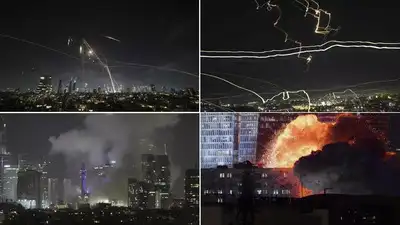
American air-defence systems and naval assets played a key role in helping Israel intercept a barrage of ballistic missiles fired by Iran on Friday, a US official confirmed, as tensions between Tehran and Tel Aviv threaten to engulf the region in a wider war.The missile launches were in retaliation for Israel’s earlier airstrikes on Iranian nuclear sites and the killing of top military leaders. According to US officials, American Patriot missile-defence batteries and Terminal High Altitude Area Defence (THAAD) systems stationed in the Middle East were activated as Iran launched multiple waves of missiles, including at Tel Aviv.
US Navy destroyers repositioned in region
Naval forces also assisted Israel’s response, though it remains unclear whether US ships fired interceptors or supported the effort with their advanced radar tracking systems.
Officials said the Navy has ordered the USS Thomas Hudner, a destroyer equipped to counter ballistic missiles, to sail from the western to the eastern Mediterranean. A second destroyer is also being repositioned to provide additional options if requested by the White House.Meanwhile, the USS Carl Vinson, currently in the Arabian Sea, remains the only US aircraft carrier in the region, but other carriers—Nimitz in the Indo-Pacific and George Washington now departing Japan—could be directed toward the Middle East if needed.
Air patrols, base alerts amid escalation
American fighter jets are now conducting air patrols across the region to protect US military personnel and installations. Air bases have increased security protocols as the US military prepares for any further escalation.President Donald Trump was briefed on the situation Friday in a meeting with his National Security Council, officials said, as forces on the ground braced for further fallout.
Troop numbers rise amid Middle East crisis
The US has approximately 40,000 troops deployed in the Middle East—up from the typical 30,000—with numbers having peaked at 43,000 last October.
This rise came amid a string of Iran-linked attacks, including Houthi strikes on vessels in the Red Sea and the October 7 Hamas assault on Israel that sparked the ongoing Gaza war.Following those attacks, then-President Joe Biden had surged naval power to the region in a show of deterrence aimed at Iran and Hezbollah. On October 1, 2024, US Navy destroyers launched a dozen interceptors as more than 200 missiles rained down on Israel from Iran.Friday’s interception efforts mark the latest demonstration of American military coordination with Israel amid deepening fears of a full-scale regional war.

 18 hours ago
53
18 hours ago
53




























 English (US)
English (US)